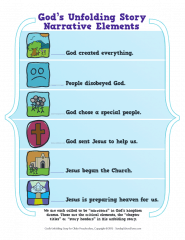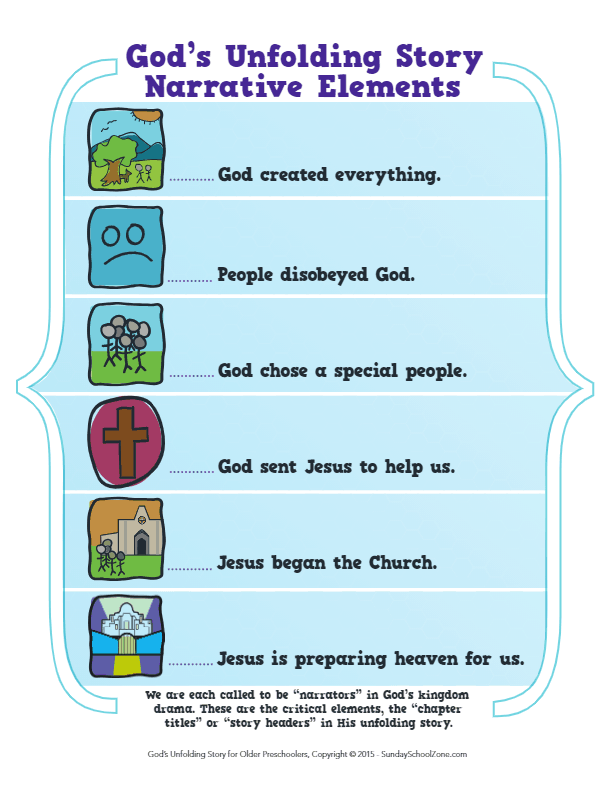God’s Unfolding Story Narrative Elements
 We believe an understanding of the biblical story is essential to developing a biblical worldview and lifestyle for anyone. The contemporary Church and those who produce resources for today’s Church historically have done a good job of telling the stories (plural) of the Bible, but not a good job of teaching the story (singular) of the Bible. We believe that reality needs to change.
We believe an understanding of the biblical story is essential to developing a biblical worldview and lifestyle for anyone. The contemporary Church and those who produce resources for today’s Church historically have done a good job of telling the stories (plural) of the Bible, but not a good job of teaching the story (singular) of the Bible. We believe that reality needs to change.
Not Ancient History
The biblical story is not ancient history. The biblical story continues to unfold. It is a story that includes people living today. It is an unfolding story, and it involves you and me.
It is our intent to summarize and articulate the biblical story in ways that are appropriate for Bible students of any age to learn. We have articulated the biblical story in six simple elements that an older preschooler can understand and learn for life. The six preschool elements provide a framework for the story that can be enhanced as learners grow and mature. We will then help churches teach the story as a framework for understanding God’s kingdom activity.
Yes, It’s Interpretive
Any summary or outline of the biblical story is, by default, an interpretation of the story because it will articulate a “story line” that implies and assigns a grand, interpretive scheme to the story. It also will have to select a limited set of broad “events” that form the story’s framework. This selection must, by necessity, be interpretive because it treats some events or groupings of events as more important to “the story” than others. We must be careful, therefore, to craft a story that falls “safely” within the mainstream parameters of historic Christian thought. We hope we have accomplished this in a responsible way.
Starting with Preschoolers
The biblical story, however we may summarize it or outline it, must be appropriate for people of all ages and should be teachable and relevant to a person of any age. In fact, God commands His people to teach the story to our “children and granchildren” (Deut. 4:9). So, it makes sense to craft the story “from the ground up,” meaning we start by crafting a story that is appropriate for preschoolers but is also then usable for any other age group.
Here’s how we outline the biblical story. We call these God’s Unfolding Story Narrative Elements. Each element has a corresponding icon as seen in this visual…
 You can download and print the page to the left. We have also created God’s Unfolding Story Cube to help with teaching and reviewing the narrative elements. The cube makes a great craft activity and can be used in a game to help children learn the biblical story.
You can download and print the page to the left. We have also created God’s Unfolding Story Cube to help with teaching and reviewing the narrative elements. The cube makes a great craft activity and can be used in a game to help children learn the biblical story.
A Story for All Ages
As learners mature, they will develop a deeper and more age-appropriate understanding of these story elements and be able to articulate the story with greater theological clarity and insight. The outline above will form the framework for the biblical story at any age. We don’t want grade schoolers and youth to learn a different story from what they learned in preschool. The biblical story doesn’t change as the learners get older, but how we/they articulate the story should change. We want them to build on the story and add increasingly complex concepts. The goal is to help churches teach all learners the biblical story in a way that is appropriate for the age group and can be retained and built upon for life. For example, a church might choose to outline the story for grade schoolers like this…
1. Yahweh created all things to show He can be trusted to love us.
2. People disobeyed because they didn’t trust Yahweh.
3. Yahweh chose Israel to bring a Redeemer and King.
4. Yahweh sent Jesus to redeem us and establish His Kingdom.
5. Jesus calls the Church to trust Him and expand Yahweh’s Kingdom.
6. Jesus is preparing an eternal and heavenly Kingdom for those who trust Him.
The point here is that the story itself does not change even if the way it’s articulated changes as learners mature.
The story elements may become even more complex for youth and adults. When placed in a narrative or paragraph form, it might look like this. . .
Yahweh, our God and King, created all things, He created people in His image and with purpose. Adam and Eve sinned because they didn’t trust in Yahweh’s goodness and character. Because of sin, humanity and the cosmos are now fallen and broken. In His love, Yahweh promised to send a Messiah to reverse the impact of sin. He then chose and called Israel to be His special people through whom He would bring the Messiah and salvation to all who trust Him. About 2,000 years ago, God sent His son, Jesus, an Israelite, to die for the sins of people and inaugurate God’s kingdom on earth. Now God calls those who trust Jesus into a spiritual community of faith; a new, expanded Israel; the Church. Someday Yahweh will consummate His kingdom and establish a new heaven and new earth where Jesus and His Church will reign and live forever.
There is no single or “best” way to articulate the biblical story. The story, or pieces of it, is told in various ways in different places in the Bible. How the basic story was told would vary depending on the circumstances at the time. The basic elements of the story would generally be present along with other aspects of the story that were relevant to that particular telling. As learners mature, the exact wording is less important than a basic understanding of the key elements of the story.
For more information about God’s Unfolding Story, here are other articles or downloadable resources…
God’s Unfolding Story Bible Study System
God’s Unfolding Story for Older Preschoolers
Getting Started with God’s Unfolding Story for Older Preschoolers



